-
Healthcare Course Catalog
Course content has been co-developed and efficacy-tested by co-development partners at renowned Health Systems across the country. Course content can be quickly deployed as is, or there are opportunities to develop new course content, supported by a dedicated content and design team.
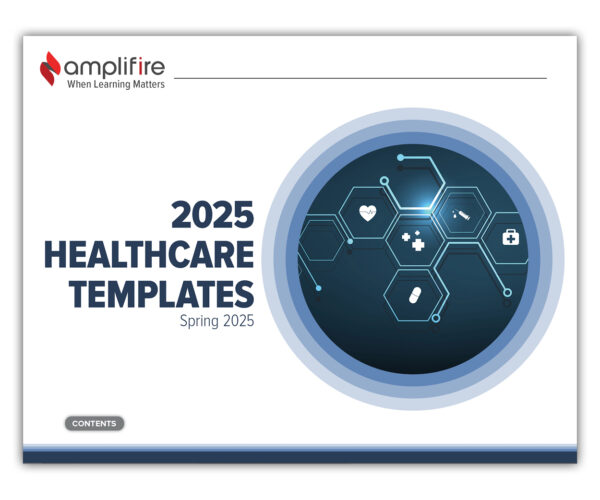
-
Recap of AONL 2025: Amplifire Highlights
The AONL 2025 event was a remarkable gathering of nursing leaders and innovators, setting the stage for the latest advancements in the nursing and medical fields. This year, Amplifire had the honor of participating and presenting groundbreaking insights on our adaptive learning platform and its critical role in reducing Hospital-Acquired Infection (HAI) rates with one of our esteemed clients, Providence. The event brought together a diverse group of professionals, all committed to improving patient care and healthcare outcomes through innovation and collaboration.
Throughout the presentation with Troy J. Larkin, PhD, RN Associate Vice President, Clinical Education & Nursing Research from Providence, we were able to emphasize how adaptive learning, with its personalized and data-driven approach, has proven to be a game-changer in the realm of clinical education. By identifying and addressing gaps in knowledge and correcting Confidently Held Misinformation™, our platform has significantly improved competency among healthcare professionals.
With improved competency, Providence saw improved outcomes. Larkin shared these substantial improvements in CAUTI (Catheter-Associated Urinary Tract Infections) and CLABSI (Central Line-Associated Bloodstream Infections) rates, showcasing a 51% decrease in CLABSI rates, equating to 85 cases avoided and 21 potential deaths prevented. These outcomes highlight the effectiveness of adaptive learning in enhancing patient safety and care quality.
Nurse Training at Scale: Decreasing HAI Rates with Adaptive Learning
During the presentation, we had the opportunity to share several crucial aspects of our adaptive learning platform that have driven these impressive outcomes. We highlighted the role of microlearning, which provides quick, focused educational interventions that are easy to integrate into busy clinical schedules. The use of patented Amplifire Analytics and Gap-Finder Technology was also a focal point, demonstrating how these tools identify and address knowledge gaps at both individual and departmental levels.
We discussed how our multi-interventional approach, tailored to the specific needs of different units, has led to remarkable improvements post-COVID. This stratified approach, combined with on-site practice observations and continuous feedback, has been instrumental in driving change and improving outcomes.
Expressing Gratitude to AONL for a Successful Event
We would like to extend our deepest gratitude to the AONL for hosting such a successful and impactful event. The opportunity to share our work and connect with like-minded professionals was invaluable. The AONL 2025 event not only highlighted the latest advancements in healthcare but also fostered a sense of community and collaboration that is essential for driving progress in the field.
In conclusion, our participation in AONL 2025 was a resounding success, and we are excited to continue our journey of innovation and excellence in healthcare education. We look forward to future opportunities to share our insights and collaborate with others who are equally passionate about improving patient care and outcomes. Thank you, AONL, for a great week!
-
Recognizing Sepsis Awareness Month: Online learning for better patient outcomes
Regrettably, at least 1.7 million adults in America develop sepsis each year, leading to at least 350,000 sepsis-related deaths in the United States. On average, 87% of sepsis cases originate outside the hospital.
As sepsis continues to be a pressing issue in healthcare, action must be taken. Recently, in her first major initiative rollout as the director of the CDC, Dr. Mandy Cohen released the CDC’s Hospital Sepsis Program Core Elements. These guidelines offer a detailed roadmap for hospitals to follow to reduce deaths from sepsis in their facilities.
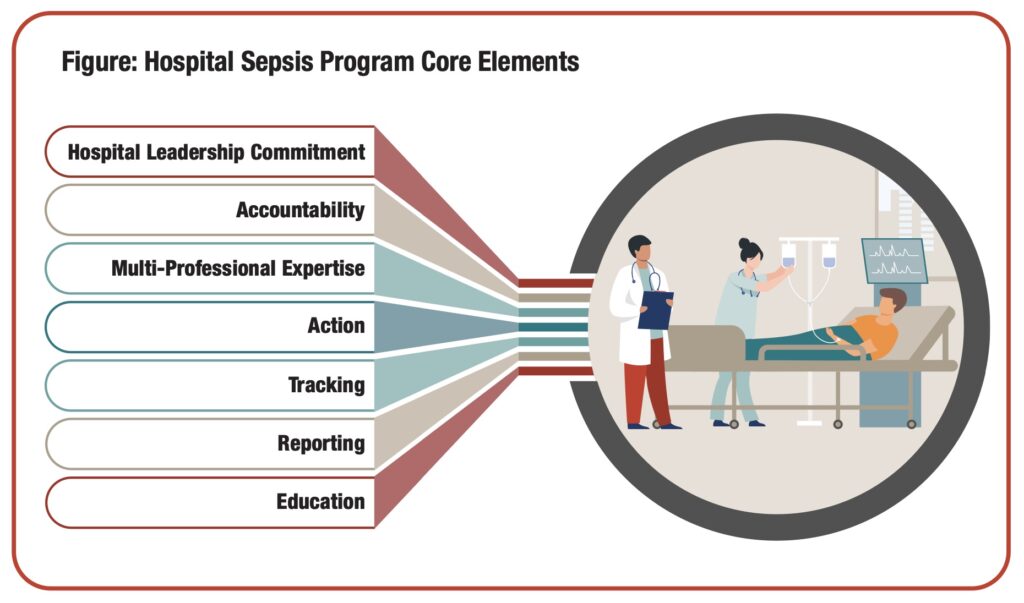
One of the seven core elements outlined in this roadmap is education. The CDC recommends, “For optimal sepsis treatment and outcomes, it is imperative that hospital staff have strong knowledge of sepsis and understand their role in team-based management of sepsis.” Examples of priority sepsis education include:
- Including sepsis-specific training and education in the hiring or on-boarding process for healthcare staff and trainees
- Providing annual sepsis education to clinical staff
The implementation of unified standard best practices delivered via effective education has been shown to improve patient safety, and can be applied to sepsis treatment, too.
A 2022 systemic review of thirty-two studies on the impact of sepsis education for healthcare professionals on patient outcomes concluded that most educational programs had an effective and immediate impact on knowledge levels, and simulation and game-based programs yielded better outcomes overall. It also concluded that, “Improvements in patient care processes and patient outcomes were associated with the concomitant existence or implementation of a hospital sepsis care bundle.” Effective training matters when standard best practices information needs to stick.
For example, central line-associated blood stream infections (CLABSIs) are often preventable — like sepsis — and rates can be reduced, if not eliminated, by adherence to evidence-based patient safety guidelines, reinforced by effective training. One hospital in a large Colorado healthcare system was selected to pilot the idea that CLABSIs could be addressed with training. After implementing Amplifire’s online learning platform, they experienced a 79% reduction in CLABSIs. A reduction of this magnitude has a profound effect, starting with improved patient outcomes, more confident and competent clinicians, a better bottom line, and most importantly, lives saved.
Want to learn more about how effective online learning can lead to decreased sepsis incidents and improved patient outcomes? Reach out. For more information about available sepsis courses, browse our course catalog.
-
Reducing Central Line-Associated Bloodstream Infection (CLABSI) Rates with Cognitive Science-Based Training
Authors
Jessica Lowery PhD, CIC, FAPICa, Matthew Jensen Hays PhDb, Andrea Burch MS, RN NEA-BCa, Debra Behr DNP, RN, CCRN-Ka, Steven Brown MD, FACRa, Elise Kearney RN, BSN, VA-BCa, Deborah Senseney DNP, RN, RN-BCa, Sky Arce MSN, RN, PCCN-Ka
aLutheran Medical Center, Wheat Ridge, CO
bAmplifire, Boulder, COAbstract
There have been many tactics throughout the years aimed at reducing central line-associated bloodstream infections (CLABSI) in the healthcare setting. To reduce CLABSI rates at this facility, we employed cognitive science-based online training directed at nursing departments. Following implementation, we found significant reductions in CLABSI rates that were sustained for a minimum of 9 months. These results demonstrate that this learning methodology can be used to help decrease CLABSI and potentially other health care-associated infections.
Training that works, saves lives:
When faced with a rise in deadly bloodstream infections during the height of the COVID-19 pandemic, Ascension Health enacted Amplifire’s eLearning platform to eliminate CLABSI with effective training. Designed to meet learners where they are, Amplifire training has been the difference in saving lives by providing training that lowered CLABSI rates by 79%.
While traditional intervention methods are financially and operationally burdensome, an effective eLearning solution is easy to implement and is respectful of caregivers’ time and knowledge. One-size-fits-all training methods simply cannot keep up with the demands and constraints of modern healthcare. Personalized training, fitted to individuals’ own knowledge gaps, uncertainties, and misinformation is the best way to help employees maximize their potential in their field.
Amplifire uses cognitive and neuroscience principles that are designed to accommodate how people naturally learn, remember, and forget. By tapping into these principles with a virtual, easily implemented, time-and-cost-effective solution, health systems can help their caregivers provide the best possible care and ensure positive outcomes.
-
Transforming Infection Prevention Training with Online Learning
While hospitals continuously work to prevent healthcare-associated infections (HAIs), they still occur. With more reports highlighting staff shortages, burnout, and overwhelming workload — problems only exacerbated by the COVID-19 pandemic — people resort to shortcuts when there isn’t enough time to meet mounting demands. Despite staff being hyperaware of infection with reminders such as infection prevention “toolkits,” posters, and graphics, HAIs increased significantly in 2021, according to the CDC (CLABSI by 47% and CAUTI by 19%, for example).
And even still, hospitals continue to combat potentially deadly cases of HAIs. A narrative review of HAIs prevention strategies cites the Joint Commission Journal on Quality and Patient Safety’s report of healthcare workers’ reasons for non-compliance with updated guidelines — and most given reasons stem from a lack of education and training about the guidelines’ strictness. Healthcare workers also went on to report high workloads and feelings of burnout. Information overload while already feeling overwhelmed prevents workers from absorbing new guidelines quickly and effectively. Any information learned is likely to be forgotten in the stress of the job.
There is so much that goes into preventing HAIs that clinicians are responsible to know and execute with confidence every day. With constant pressures upon them — both systemic and job related — healthcare workers need that extra support from their organizations. That’s where effective and personalized learning can make a difference for both staff and patients’ safety.
Ultimately, it boils down to giving the highest quality care to patients. When mistakes are made and HAIs occur, patients, their families and their caregivers suffer — which poses an emotional burden to healthcare workers who aim to deliver the best patient care. Amid a healthcare worker crisis, it is up to organizations to offer as much support as possible. Regular training in infection prevention best practices is the best way to curb HAIs, but garnering buy-in for more training can be a hurdle. This is especially true if training efficacy can’t be measured. However, if training efficacy can be measured and has been shown to deliver significant ROI (such is the case with Amplifire), that may be the push you need to ensure your staff is well supported and performing at their highest potential.
Why science-based training matters
For learning to deliver tangible results, it has to stick. Amplifire’s platform is built from brain science discoveries that induce powerful, lasting learning at a much faster rate. These discoveries — pioneered by our Science Advisory Board — include “cognitive triggers” that have proven to help people learn faster and retain more, which provides an advantage when it comes to optimizing training.
The unfortunate reality is that people are designed to forget — it’s a natural part of being human. In fact, the process of forgetting is actually beneficial to cognition and learning (learn more about that intricate process here). But by harnessing the aforementioned cognitive triggers, Amplifire’s learning platform attacks what is known as the forgetting curve, forging stronger memories for information that matters, especially when it comes to infection prevention training.
Science-based training matters because it is the most effective way to ensure important, life-saving training sticks in the minds of learners. Major health systems that have partnered with Amplifire for infection prevention training have seen astonishing results, including significant reduction in HAIs and HAI-related deaths. Ultimately, infection prevention training should empower clinicians and help their organizations reduce HAIs. With the power of brain science and adaptive, personalized learning, Amplifire helps organizations reach their infection prevention training goals. Here’s how.
How Amplifire training delivers positive outcomes
For clinicians
In addition to applying brain science principles to learning, the Amplifire platform also rigorously personalizes the learning experience. Our adaptive platform tailors learning to each person by adjusting to individuals’ knowledge gaps, uncertainties, and misinformation. By personalizing the learning experience in this way, learners only spend time on the things they don’t know. This is important for clinicians because it:
- Respects clinicians’ time. Clinician satisfaction improves when organizations show they value their time and knowledge.
- Gets clinicians back on the floor faster. Clinicians spend less time in training and more time helping patients.
- Gives clinicians confidence. Clinicians feel better prepared to provide the best possible care for their patients, boosting morale.
In the figure below, Amplifire visualizes the importance of personalized learning in CAUTI prevention training at an East Coast hospital. Without Amplifire, there is no way to know exactly what each clinician does or does not know, posing a significant risk in HAI prevention.
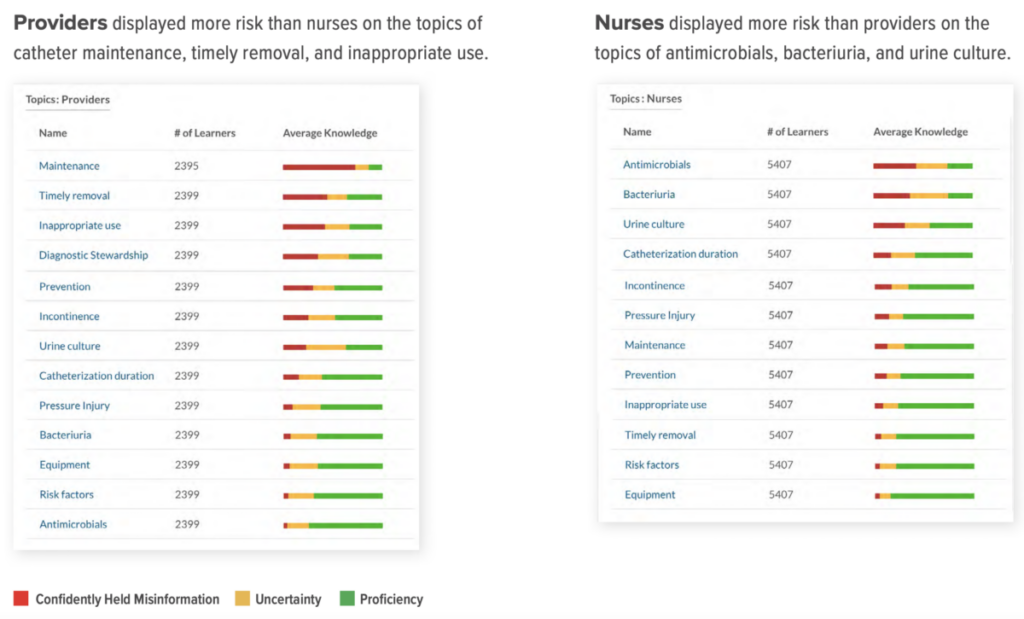
In the CAUTI prevention course, clinicians and nurses posed different risks based on their differing knowledge gaps, uncertainties, and misinformation. Therefore, the Amplifire platform adapted their learning experience to their knowledge level for optimal learning, yielding the benefits described above from the clinician perspective.
What’s more, training doesn’t have to be boring, either. Personalized learning can combat adverse feelings associated with training. Amplifire has a gamification feel that stimulates dopamine and makes learning enjoyable.
For patients
Patients are at the center of all HAI prevention training objectives. The main goal of HAI training is not just to cut down on training time and associated costs, but it is to improve patient outcomes and save lives. Again, HAIs continued to increase significantly in 2021, even with scrupulous prevention efforts by healthcare organizations.
Despite the national average increase in HAIs, a hospital at a large U.S. healthcare system saw CLABSI rates fall by 79% in under a year following the adoption of Amplifire training. When compared to the control hospital, the result was undeniable.

Continuing the CAUTI example from the previous section, Amplifire training empowered those physicians and nurses to achieve a 38% decrease in CAUTI incidents. These HAI reductions have tangible effects on patient outcomes, and clinicians can be proud of the impact they’ve made in patients’ lives.
For organizations
For healthcare systems, clinician satisfaction and positive patient outcomes are of paramount importance. Organizations’ prosperity heavily depends on these factors.
Like we previously discussed, personalized learning allows learners to only spend time learning topics they don’t know, so they don’t waste time learning the things they’ve mastered. This effective and efficient learning model slashed learning time and cuts costs associated with more time spent learning and learning in the classroom if organizations haven’t yet adopted blended or virtual learning. It also allows providers to get back to the floor faster, increasing billable hours.
With clinicians who are more satisfied with training that respects their time and empowers them to do their best work confidently, hospitals achieve higher retention rates. By keeping good employees, hospitals cut onboarding costs and reduce turnovers.
In addition to diminished patient wellbeing, HAIs pose a significant monetary risk to organizations. It is estimated that 250,000 CLABSIs occur in the U.S. every year, and the AHRQ estimates the average cost of each CLABSI at approximately $48,108. At a health system that deployed Amplifire’s CLABSI training and decreased bloodstream infections by 49%, they achieved $3.8 million in savings. Imagine what the 79% reduction we described above could achieve in savings — savings that could be put to work to improve hospital prosperity, enabling health systems to provide top-tier care.
These points considered, the return on investment associated with Amplifire training can be as much as 25-fold. Effective training is absolutely critical to prosperity and future proofing your organization. Amplifire has proof of learning and powerful returns to show the value of a science-based, adaptive learning platform.
When lives are at stake, there is no place for shortcuts. Amplifire supports the Institute for Health Improvement’s Quadruple Aim, rounding off better health, better care, and low cost with clinician wellbeing. Clinicians are the backbone of patient care; when clinicians are well supported, especially with adequate and effective training, the core elements of what was formerly the Tripple Aim become more achievable. To be a well-rounded organization, it’s essential to empower employees with lifesaving, HAI-preventing training that propels your organization to prosperity.
From the beginning, Amplifire has relied on innovative brain science to guide its product development to create the most effective learning and training solution, perfectly tailored to the way the human brain works. Learn more about how Amplifire helps people learn better and faster by checking out a demo.
-
Aortic Dissection: Deploying Training that Saves Lives
Aortic dissection is a relatively rare heart condition that is lethal if not quickly and aggressively treated. Sadly, it often goes undiagnosed. In fact, physicians only correctly suspect the condition 15% to 43% of the time and the misdiagnosis rate holds steady at 35%. The aortic dissection death rate has not declined in decades, despite medical advancements.
In light of these discouraging figures, this healthcare organization decided to fortify their physicians to be the exceptions from missed diagnoses. They deployed Amplifire training to identify any knowledge gaps, uncertainty, or misinformation about aortic dissections and to instill diagnostic best practices.
Major Risk Exposed
Amplifire’s platform revealed through its Aortic Dissection Diagnoses course, that nearly half of physicians were either confidently misinformed or uncertain about the critical difference between medical and surgical aortic dissections. This hidden risk posed a threat to the physicians, the organization at large, and, most importantly, the patients who trust the organization to provide expert care.
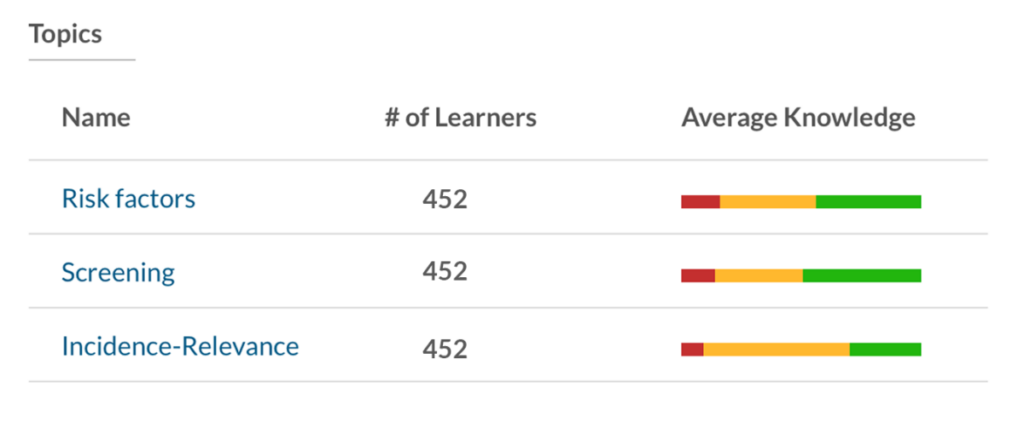
Aortic Dissection Risk Exposed
Amplifire revealed high levels of uncertainty on critical topics.
Clinical Implications
Using proven-effective adaptive learning techniques based on brain science, Amplifire’s platform eliminated hidden risks and empowered physicians within this organization to provide exceptional patient care.
Download the full case study to see the powerful results of and impactful returns of Amplifire training.
-
Knocking out 79% of CLABSI events
Reducing the Incidence of CLABSI
250,000 central line-associated bloodstream infections (CLABSIs) occur in the US every year. They have a mortality rate of 12% to 25%. CLABSIs are often preventable, and rates can be reduced, if not eliminated, by adherence to evidence-based guidelines.
To help tackle this problem a large health system employed Amplifire to determine what its nurses did and didn’t know about CLABSI prevention. In one hospital, 536 nurses received an Amplifire course on CLABSI. Results from the pilot hospital were then compared to CLABSI rates in the other hospitals, which did not receive Amplifire training.
CLABSI Knowledge Findings:
Observations
- 536 nurses generated 13,936 data points
- 2,968 instances of Confidently Held MisinformationTM (CHMTM) found and fixed
- 4,014 instances of uncertainty found and fixed
- The most misinformed staff spent 19 minutes in the platform on average, while those who were already proficient spent only 11 minutes.
- By the end of the course, 100% of staff were proficient (both confident and correct) on all the material.

Solving Knowledge Problems That Lead to Risks
If healthcare practitioners commit to “owning” the lines of patients with CVCs and adhere to evidence-based prevention strategies, CLABSIs can be eliminated. In the time period following Amplifire training, the CLABSI rate at the pilot hospital fell significantly. Complete the form below to download the full case study and see the final outcomes.
-
38% decrease in CAUTI incidents after Amplifire
Reducing the Incidence of CAUTI
CAUTI is the leading cause of avoidable harm and the most common hospital-acquired condition. Shockingly, studies regularly find that as many as 50% of indwelling urinary catheters in patients are unnecessary. They should not have been ordered. The harm they may potentially cause is entirely avoidable.
To help combat this problem, a major east coast hospital developed and deployed the Amplifire CAUTI Prevention course to its nurses snd providers teaching them the bundle of protocols that have been shown to substantially reduce the incidence of CAUTI. The results have been impressive with a 38% decrease in CAUTI incidents.
CAUTI Knowledge Findings:
Observations
- 8,145 clinicians generated 154,755 data points
- 5,721 nurses
- 2,424 providers
- 26,308 instances of CHMTM found and fixed
- 27,855 instances of uncertainty found and fixed
- 100,591 instances of existing proficiency
- The most misinformed staff spent 81 minutes in the platform on average, while those who were already proficient spent only 10 minutes.
- By the end of the course, 100% of staff were proficient (both confident and correct) on all the material.
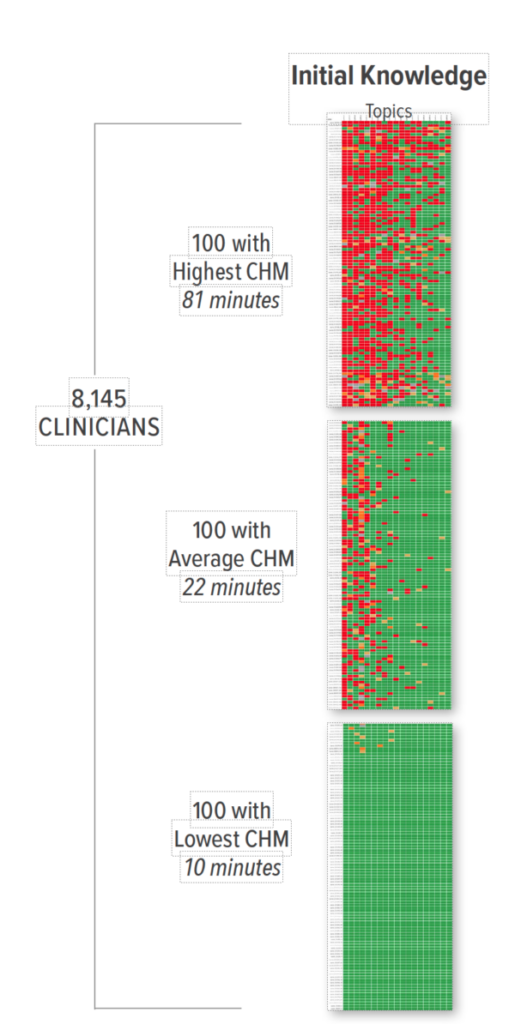
Confidently Held MisinformationTM and Implications
Amplifire discovered a significant amount of Confidently Held MisinformationTM (CHMTM) around urinary catheters when it came to equipment maintenance, catheterization and incontinence and antimicrobial stewardship. Complete the form below to learn about the clinical implications of misinformation about CAUTI.
-
Improving Pediatric Sepsis Protocols

Matthew J. Hays, PhD
Senior Director of Research and AnalyticsSepsis is the leading cause of death in children worldwide, with mortality rates between 4% and 20% in different pediatric populations and settings. When sepsis has become severe, death becomes 8% more likely for every hour that antibiotics are delayed. Timely diagnosis and treatment are the difference between life and death.
In response, Children’s Hospital Colorado (CHCO) has spearheaded a sepsis quality improvement initiative focused on improving early detection and effective management of sepsis. The goal was to use training to support clinicians’ quick, confident, and correct decision-making when pediatric sepsis is or should be suspected. The details of this endeavor were published in the latest edition of Pediatric Quality & Safety.
In the article, CHCO physicians Justin Lockwood and collaborators describe the development of a new sepsis course. The course integrates current national guidelines as well as best practices developed at CHCO to improve the recognition and management of pediatric sepsis. This course was jointly developed by sepsis experts at CHCO and the Amplifire Healthcare Alliance (AHA), a federation of top health systems working together to improve care and reduce harm.
The course was then deployed through Amplifire’s adaptive e-learning platform to frontline personnel. CHCO chose to partner with Amplifire on this effort for two reasons. First, Amplifire training has been shown to improve patient care and clinical outcomes. Second, Amplifire is built to detect when providers are sure that their knowledge is accurate or their decisions are sound—but they’re actually wrong. This confidently held misinformation (CHM) directly leads to missed diagnoses and even patient harm. “Amplifire introduced us to the concept of confidently held misinformation,” said Dr. Dan Hyman, CHCO’s Chief Medical and Patient Safety Officer.
Adaptive E-Learning
Amplifire’s training software is able to have clinical impacts because it is designed entirely around how we learn and remember. The Amplifire experience begins with questions about the learning objectives. Amplifire takes this question-first approach because well-designed questions can prepare the brain to learn. Many of the questions are asked in a multiple-choice format, which has been shown to improve the transfer of training beyond a single item’s learning objective.
When responding to questions in Amplifire, learners indicate the answer(s) they believe to be correct as well as their confidence in their decision, a patented process that improves long term memory for the material.

A sample question in CHCO’s Amplifire pediatric sepsis training module Learners receive immediate feedback on whether their response was accurate and how their confidence was calibrated (e.g., “you were partially sure and one of your answers was correct.”). When a learner confidently answers a question correctly, corrective feedback is withheld; learners’ time is better spent on more productive activities. On the other hand, low-confidence correct answers and incorrect answers (especially in cases of CHM) are accompanied by delayed corrective feedback, which has been shown to differentially enhance learning.
The result is training that has unprecedented impacts on outcomes. One AHA member reported a 32% reduction in CAUTI when nurses were trained with Amplifire. In another study, Amped nurses reduced CLABSI by 48%. Current investigations suggest that Amplifire helps providers reduce sepsis mortality rates, prevent pressure injuries and patient falls, and reduce surgical-site and C. diff infections.
Findings and Implications
At the time of publication, a total of 1,129 CHCO providers had used Amplifire; over 300 more have since completed training. Amplifire’s flexible, modular approach to content enabled CHCO to train RNs, MDs, and APPs in non-ICU inpatient and ED settings.
The average learner took 27 minutes to complete the training. Some of the component items were basic tests of knowledge. Others presented interactive cases and scenarios that required learners to judge the best course of action. In all cases, the Amplifire platform tracked CHM as well as when learners struggled to overcome a stubborn misconception. This information can be reviewed visually in the heatmaps below.

Amplifire heatmaps showing items in columns and learners in rows. The left heatmaps shows the distribution of CHM; the right shows where providers struggled to learn. Within each heatmap, the learners are sorted top to bottom, from greatest to least CHM/Struggle; the items are sorted left to right in the same way. The top left of each heatmap (circled) represents the learner-item combinations with the greatest likelihood to cause issues in the prevention and management of pediatric sepsis at CHCO. Amplifire’s heatmaps can depict different aggregations of learners (e.g., by manager, department, shift) and content (e.g., by topic). Operational issues can quickly emerge; perhaps everyone who works for Chris shares the same misconception, or all nurses in a particular wing struggle with a particular procedure. Administrators can then evaluate and remedy these problems. According to Dr. Hyman, the heatmaps pinpoint exactly where “and how much work we have yet to do.”
Dr. Lockwood summarized Amplifire’s dual capabilities by saying that “the use of confidence-weighted testing allowed us to provide needed education to frontline clinicians while simultaneously identifying areas of risk for ongoing sepsis improvement. In this way, the impact and sustainability of our educational intervention was improved.”
Efforts are currently underway at CHCO to use Amplifire in other patient-care quality improvement initiatives. For a full list of available Amplifire courses, click here. To see their impacts on clinical and performance outcomes, see Amplifire’s case studies. To learn more about the Amplifire Healthcare Alliance, which includes systems like CHCO, Partners Health, Intermountain Health, Banner Health, and more, click here.
Reference: “Is this Sepsis?” Education: Leveraging Confidently Held Misinformation and Learner Struggle
-
The Next Step in Eliminating CAUTI:The Leading Cause of Avoidable Patient Harm
The Next Step in Eliminating CAUTI:
The Leading Cause of Avoidable Patient HarmAbout 30 million Foley catheters are inserted each year, leading to nearly 1 million catheter-associated urinary tract infections (CAUTIs). These infections are the most commonly reported hospital-acquired condition (HAC). Shockingly, studies regularly find that as many as 50% of patients’ indwelling catheters are unnecessary and should not have been ordered, and even properly ordered catheters result in many infections that are avoidable if guidelines are strictly followed.
Rates for every kind of hospital acquired infection (HAI) were reduced between 2009 and 2014—except CAUTI. Despite all efforts, CAUTI has been resistant to improvement.
A major US health system employed the Amplifire training tool to acquire data on what its nurses knew and didn’t know about managing urinary catheters, and to find and fix any misinformation. Could the nurses identify when catheterization is indicated? Did they know how catheterization tubing and equipment should be handled? Were they confident in their knowledge? Was their confidence justified?
Knowledge and Confidence About CAUTI:
Before and After AmplifireObservations
- 25,826 instances of CHM found and fixed
- 23,752 instances of uncertainty found and fixed
- The variation of CAUTI knowledge was high, with some nurses extremely misinformed and others showing confident mastery of the topic.
- Nurses who were most misinformed spent almost half an hour in the module, while nurses who were most knowledgeable about CAUTI spent only 11 minutes.
- By the end of the course, 100% of the nurses who completed were confident and correct on all the information.


Confidently Held Misinformation and Implications
Amplifire discovered a significant amount of confidently held misinformation (CHM) around urinary catheters when it came to equipment maintenance, catheterization and incontinence and antimicrobial stewardship.
